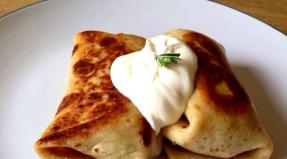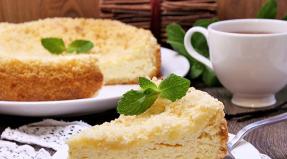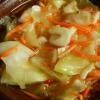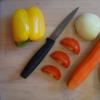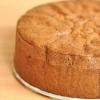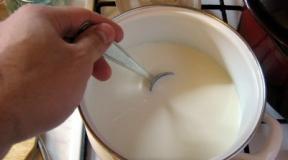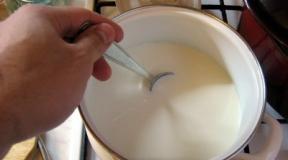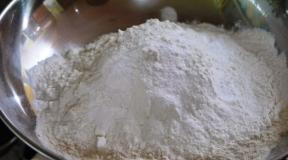Food of the gods. Longevity Secrets of the Ancients
Brezhnev's personal chef wants to open a haute cuisine academy in Kazan
The president of the Russian Culinary Association, Viktor Belyaev, worked in the Kremlin kitchen from 1975 to 1990, and then for eight years he served as general director of the Kremlin food factory of the Administration of the President of the Russian Federation. This summer, he advised the Universiade, and now he wants to open a culinary academy in Kazan, where "Kremlin old men" will teach. Not those who cooked in the cauldron of politics, but people who knew the Kremlin cuisine on duty: international-class chefs, the last bearers of the traditions of haute Soviet cuisine and connoisseurs of new culinary podiums.
Viktor Belyaev, president of the Russian Culinary Association, told a VK correspondent what these chefs were preparing for the inhabitants and guests of the Kremlin.
I have one pleasant story connected with Tatar cuisine, - says Viktor Belyaev. - I often made noodles in Tatar style: from some yolks, without adding protein. And Indira Gandhi really liked this dish. I often had to feed her. And one day she came not just to thank me, but even wrote down the recipe.
- But when you advised the cooks of the Universiade, you didn’t even remember noodles ...
You will be surprised, but at the Universiade, in addition to sports, there was also a culinary rehearsal. For ordinary viewers, we have prepared echpochmaki-peremyachi. And for VIP guests, they tried to make dishes of molecular cuisine (this is when the product is broken into molecules and foams with different tastes are prepared from it). The fact is that the menu of the Universiade was approved not by us, but by the organizers of the ceremonies. They asked: "Surprise us, show everything you are capable of!". This is where we messed up. But, thank God, no one wanted to eat "foam", the peremyachi did not go either. Therefore, we made a new menu for the ceremony. For VIP guests, the dishes were simplified: they made a lot of cuts of fish and meat. And the dishes for the audience, on the contrary, were complicated: they made special hamburgers and sushi. This is also one of the trends: the best chefs of the planet are now trying to prepare national dishes in such a way that they correspond to the modern tastes of customers, fashion ...
- And what is now fashionable on the culinary catwalks?
Well, first of all, it is necessary to make something traditional fashionable. My colleague, international judge of the Culinary Olympic Games and world culinary competitions, coach of the Italian national culinary team, host of culinary shows on the BBC, Domenico Maggi, visited Kazan with me. He said that in order to preserve the Tatar cuisine, we need to start thinking about how to convert it into semi-finished products. Otherwise, fast food will replace it forever.
Well, and high fashion, as you know, sometimes happens with excesses. About ten years ago, for example, at culinary olympiads and competitions, everyone suddenly began to make pastes and fill them with a huge amount of gelatin, they wanted to make dishes beautiful, but they forgot about the taste. This disgrace was stopped by the new head of the world association of culinary specialists Bill Galahar - well done! Once he said so: "Are you making hats? Or food? Bring back the taste!"
- Tell me, Viktor Borisovich, what was it customary to serve to guests and residents of the Kremlin?
The tables that we laid at the Kremlin receptions, we called "ships". They were followed by at least a thousand people. Erich Honecker came from the GDR, Janos Kadar came from Hungary, I fed Nicolae Ceausescu, Todor Zhivkov, Fidel Castro. Guests were treated to caviar. They served it in caviar bowls that we made from ice. And it was a hell of a job. I had to cut out the outlines of the Kremlin wall with a soldering iron, and the ice in my hands melted, and sometimes everything had to be started all over again. We dipped the finished caviar in a beetroot decoction to make it look like ruby stars. Tea was served in crystal glasses on crystal saucers. When a lemon slice lay on such a dish, it looked incredible! The dishes were stamped, not a single wrinkle was allowed on the table.
And the range of dishes was magnificent. In the middle of the table they put "image", huge, amazing dishes: meter-long sturgeons on cupronickel dishes. Snack pigs stuffed with pork, chicken and nuts - pine nuts or hazelnuts. To make the piglet shine, it was poured with jellied meat. The black grouse and pheasants were amazing, which we decorated with feathers.
- Were there forbidden foods that were not allowed to be served to distinguished guests?
Certainly. For example, forest mushrooms. We used only mushrooms grown in artificial conditions. We haven’t taken fish yet, so that no one chokes on the bones. Well, the health of the guests was not forgotten. For some, instead of cognac, a rosehip drink was poured into a bottle, to which lemon was added for shine. Instead of fried meat, to whom it was not shown, boiled meat was served. There were those who were offered broth in a bowl. But no one left unfed! We also didn’t use poppy seed filling in baking, because the seeds could get stuck in the teeth of distinguished guests, and this was not very aesthetically pleasing.
- What did they drink outside the Kremlin walls?
For dessert, we served cakes, cranberry mousse, parfait, sambuco. Cognac was served before desserts, because it burns fat very well. Champagne was served before fruit. "Soviet", mostly brut. But, I think, it was impossible to find such champagne in stores. It seems to me that it was nevertheless produced in some special workshops from special grape varieties using special technologies. In general, the products in the kitchen were only domestic. Delicacies were brought from all over the USSR! Lampreys were delivered from the Baltic states, eels from the Tver region, fruits and cognac from Armenia, Borjomi and wine from Georgia, homemade sausage from Ukraine.
Drinks were also served in abundance. The Kremlin loved fruit drinks: cranberry, lingonberry and blackcurrant. And from alcoholic - vodka and wine.
You want to open an academy of Kremlin cooks in Kazan. Will you tell stories from the life of the Kremlin to students?
Well, maybe something. Well, for example, my teacher was Stalin's personal chef. Vitaly Alekseevich said that under Stalin, tables were set more luxuriously than under Brezhnev. But here's what is striking: after the feasts, the remnants of untouched food were immediately thrown away. Even black caviar. Probably, so that the "servants" do not get used to delicacies. And under Brezhnev, the leftovers were treated to employees of various Kremlin services. And you know what else is curious: Stalin hated the smell of cooking food. If he suddenly felt the smell of fried onions or stewed cabbage, a terrible scandal began. Maybe it's because his mother was a cook. In general, food was brought to Stalin in a dish covered with a lid, and on top - with a towel. By the way, at the dacha in Kuntsevo, which was built according to Stalin's project, the kitchen was located at a distance of 200 meters from the residence.
You talked about meeting with Indira Gandhi. Did you have to personally communicate with any of the greats on culinary topics?
Once, at the height of the Cold War, a request flew through the Kremlin kitchen: Thatcher asks for tea, he asks for tea! And I must say that no matter how much this iron lady came to Moscow, she never ate with the Russians. I ate only in my English embassy. And suddenly this unplanned request from her! Usually we served cheese, ham, toast, jam, "doctor's" sausage for breakfast to the first persons of the state, which is not available now. And that morning I had nothing to offer the Englishwoman for tea, except for six palachinki, left over after a plentiful Kremlin breakfast prepared for other guests. And I gave her all six palachinki with cottage cheese. The cottage cheese in them was mashed with sugar and lemon zest. As for tea, then they drank only black, mixing Georgian and Indian varieties for taste. If coffee was brewed, then for the refinement of taste, a little instant was added to it. A couple of minutes later they returned the empty plate to me: Thatcher ate everything that was put to her! And they gave me a sign to go to the lady. Thatcher stood near the entrance in gloves, preparing to leave. But when she saw me, she smiled, took off her glove, and shook my hand.
That's when I gratefully recalled the etiquette lessons that we were given in an ordinary culinary college. After all, four times a week we, ordinary cooks, were told how to serve a dish, how to talk to a woman ... And recently I gave lectures at the Plekhanov Academy on the nutrition of top officials. And I heard a remark from the audience: "Viktor Borisovich, is it true that primary food processing was taught in the culinary technical schools of the USSR?" What is going on with the frames? Cooking training programs make it so easy that would-be chefs aren't even taught how to debone meat! They say: "But why? After all, the meat is now delivered to the cook in the form of ready-made fillet - so why fence the garden? And there are not enough teachers in the academies to read such nuances." Optimization! But I’m thinking: what if he takes the fillet and doesn’t come to the cook in the kitchen. What if there is a force majeure? What will this idiot do then? So many disciplines have now been withdrawn from modern programs for the preparation of cooks ... But in the end? There are no more diet canteens, we have lost the culture of workers' canteens, the hospital food system, food for children. And we thoroughly read 16 diets!
- And what is now served on the table to Putin, say?
Tables-ships have sunk into oblivion. Now round tables are being set. The presentation of the food was different. They no longer serve sturgeon, whole piglets. Now everyone is doing it in portions: first, a cold fish appetizer, then a meat or salad, then hot, dessert with tea. Huge common vases with fruit were also abandoned. Instead, they now serve personal two-story shelves with berries. And they also make miniature baked goods now.
- Viktor Borisovich, what gastronomic impressions will you take away from Kazan?
Amazing lamb is sold in your Kazan markets. In Moscow, you will not find this, I always buy lamb in Kazan.
In general, the taste of national cuisines is the wealth of Russia. I can cook azu and chak-chak with my eyes closed. In 2014, the European Culinary Cup will be held, and in 2017 - the Culinary Olympiad. The main task there will be - to lay the "middle table" of their country, a typical one. Now, if we put cabbage soup and herring, then we will not surprise anyone. And if we set the table with food that is eaten in different parts of Russia: in Siberia, in the Urals, in Tatarstan - this will be an event ... National cuisines should know each other, which is why we want to open the Kazan Academy of Culinary. We have already held meetings on this topic with your prime minister and the mayor of Kazan.
By the way, promoting national cuisine means at the same time affirming the principles of locavor, that is, trying to use not imported products, but local ones. Why do we need a Spanish tomato or a Chinese cucumber? Can't we grow them ourselves? From mass consumption it is necessary to move on to better quality. In Yaroslavl, we have already begun such an experiment: we were instructed to develop a menu for school meals, and we have already found local farmers there ...
Chapter:
Dishes of the Kremlin cuisine
2nd page
BROTHS & SOUPS
Kremlin chefs not only use culinary recipes from a variety of sources, but also compose them themselves. Their gourmet dishes are truly works of art, and the chefs themselves are simply culinary artists.
The Kremlin kitchen provides both the organization of ceremonial banquet tables, as well as the usual daily meals for employees, children's and individual diet meals.
All the dishes on the Kremlin table are the fruit of a long analysis, discussions and endless tastings of the highest class culinary specialists, sanitary doctors and nutritionists.
Kremlin chef talks about the menu of the heads of state - Galkin
Presidential kitchen - Galkin
Chef Anatoly Galkin - working day
Kremlin chef: photo with a worm is a fake
Jérôme Rigaud - Kremlin Chef
The Kremlin is full! - Anatoly Galkin and Barack Obama (Galkin's story)
Master class from the Kremlin chef - Viktor Belyaev
The Kremlin chef shared the secrets of the kitchen
Government Kitchen! Viktor Belyaev
meat broth
Ingredients
:
500 g of meat, 2.5-3 liters of water, salt to taste.
Cooking
Wash the meat under running cold water, put it in a saucepan, pour cold water over it. Cover the pan with a lid and put on a strong fire so that the water boils faster, and then reduce it, preventing a violent boil.
Remove the foam and fat that appeared during boiling.
After 1-1.5 hours after the start of cooking, add salt. When the meat is ready (after 2.5-3 hours; the readiness of the meat is checked with a fork: if it freely pierces the meat, then it is ready), it must be removed from the broth and put in another bowl, and strain the broth.
Meat broth is used to prepare various soups, cabbage soup, borscht, etc.
The meat is served with soup or used to prepare various dishes.
Meat broth can be boiled with roots: after removing the foam from it, put peeled and washed carrots, turnips, parsley and onions.
fish broth
Ingredients
:
500 g fish, 1 onion, 1 parsley root, 1 bay leaf, 3-4 black peppercorns, salt to taste, 2-3 liters of water.
Cooking
A good fish broth is obtained from small fish (zander, perch), as well as from scap, mackerel, sable fish and catfish.
Clean the fish from scales, cut the abdomen, remove the insides, rinse, cut into portions, remove the gills from the heads.
Put the fish prepared in this way in a saucepan, pour cold water over it, add salt, roots and onions. Then close the pan with a lid, bring to a boil, remove the foam and cook over low heat for 25-30 minutes.
After that, take out the pieces of fish, and continue to cook the head and fins for another 15-20 minutes.
When cooking fish with a specific smell and taste, you can add cucumber pickle (200-800 g per 1 liter of water), or peel from pickles, or vinegar.
Strain the finished fish broth and use for making soups and hodgepodges.
mushroom broth
Ingredients
:
50 g dry mushrooms, 2-3 liters of water, 1 onion, salt to taste.
Cooking
Rinse dry mushrooms thoroughly in warm water, put them in a saucepan, add the peeled and halved onion, pour cold water and cook at a low boil for 2-2.5 hours.
Strain the finished broth.
Rinse the mushrooms with cold water, finely chop and put in a soup prepared with mushroom broth.
hunting kulesh
Ingredients
:
For 4 servings: 1 chicken, 100 g lard, 1 liter of water, 1 onion, 10 tomatoes, 10 eggs, salt, 10 g parsley, 10 g dill, ground black pepper to taste.
Cooking
Cut the chicken into small pieces, stew. Finely chop the salo and fry in a brazier, adding finely chopped onion there. Mix chicken pieces with bacon, onions and fry all this with constant stirring so as not to burn.
Then put in a pot of water (about 2 liters of water per chicken) and bring to a boil. When the water boils, throw a glass of already sorted, washed rice there and cook for 15-20 minutes.
After that, rub 10 fresh tomatoes and add to the kulesh. Then take 10 eggs, beat and pour through a sieve into the same place. Let the dish boil for 5 minutes and salt to taste.
Then finish off the greens in the kulesh. Do not boil, just cover the dish with a lid and let it brew.
Muscat broth
Ingredients
:
1 liter chicken broth.
For dumplings: 100 g semolina, 1 egg, 1 egg yolk, 1 tablespoon water, 2 tablespoons olive oil, salt, nutmeg, 1 teaspoon finely chopped parsley.
Cooking
Beat eggs, add water, olive oil, grated nutmeg, salt, semolina, herbs. Mix everything thoroughly, separate the oblong dumplings with a spoon, dip in slightly salted boiling water and cook over low heat until they float.
Remove the dumplings with a slotted spoon and place in the prepared chicken broth.
Vegetable milk soup
Ingredients
:
500 g of lettuce or spinach, 50 g of carrots, 2 cups of milk, 2.5 cups of water, 2 tablespoons of butter, 2 tablespoons of wheat flour, 2 egg yolks, salt to taste.
Cooking
Rinse lettuce and spinach in several waters, put it on a sieve, then chop it, put it in a saucepan, add chopped carrots, butter. Stew everything in your own juice, closing the pan with a lid.
Then dilute the lightly fried wheat flour in milk, half diluted with water, and add vegetables to it. Boil them for 30 minutes, then wipe through a sieve, salt to taste, heat for a couple.
Before serving, add the yolks diluted with a small amount of warm soup to the finished soup.
Borscht with trepangs
Ingredients
:
150 g dried sea cucumbers, 100 g beets, 80 g cabbage, 50 g carrots, 20 g parsley, 50 g onions, 80 g potatoes, 25 g tomato paste, 20 g melted butter, 20 g sour cream, 5 g sugar, 5 g of 3% vinegar, bay leaf, black peppercorns, parsley, salt to taste.
Cooking
Rinse dried sea cucumbers in warm water, pour cold water for 24-30 hours to swell (change water 2-3 times). Then cut along the abdomen, clean from the remnants of the insides and cook for 2-3 hours. Boiled trepangs cut into strips.
Cut beets, carrots, parsley root, onions into strips, add tomato paste, melted butter, a little water and simmer until tender.
After 20-30 minutes, add white cabbage and continue to simmer. In the boiling broth left over from cooking the trepangs, put the potatoes cut into cubes, stewed vegetables, bay leaf, black peppercorns 10-15 minutes before the readiness.
Season the borscht with salt, vinegar and sugar.
At the end of cooking, put boiled trepangs into the borscht.
When serving, add sour cream and finely chopped parsley to a plate with borscht.
Ukrainian borscht
Ingredients
:
500 g of meat, 400 g of cabbage and potatoes, 250 g of beets, 1/2 cup of sour cream and tomato puree, 1 pc. roots, 1 onion, 20 g lard, 1 tablespoon butter, garlic, vinegar, bay leaf, allspice and bitter pepper, salt to taste.
Cooking
Boil the meat broth and strain. Peeled roots, onions and beets cut into strips. Sliced roots and onion lightly fry in butter, mix with toasted flour, dilute with broth and bring to a boil. Stew beets for 20-30 minutes, adding fat, tomato puree, vinegar and broth (you can also pour in bread kvass).
In the broth prepared for borscht, put potatoes cut into large cubes, coarsely chopped cabbage, stewed beets, salt and cook for 10-15 minutes, then add the roots fried with flour, bay leaf, allspice and bitter pepper, cook until the potatoes and cabbage will not be ready.
Season the finished borscht with bacon, mashed with garlic, add sliced tomatoes, quickly bring to a boil, then let the borscht brew for 10-15 minutes.
Pour borscht into bowls, put sour cream and sprinkle it with finely chopped parsley.
Shchi from fresh cabbage
Ingredients
:
500 g of meat, 500 g of fresh cabbage, 200 g of roots and onions, 2 tablespoons of butter, 200 g of tomatoes, 200 g of potatoes, 1 bay leaf, salt and pepper to taste.
Cooking
Put the meat broth on to boil. After 1.5-2 hours, remove the meat, and strain the broth into a soup pot and add cabbage. Bring to a boil, add pre-fried roots, onions, then put the meat and cook for another 25-30 minutes.
5-10 minutes before the end of cooking, add peppercorns, bay leaf, and salt to the cabbage soup.
During cooking, you can put potatoes, tomatoes in cabbage soup. In this case, the potatoes should be added 15-20 minutes after the cabbage was put in, and the sliced tomatoes should be added at the end of cooking, along with seasonings.
Before serving, put a piece of meat, sour cream, finely chopped parsley and dill in each plate.
Pearl barley soup with mushrooms
Ingredients
:
50 g of onions, 40 g of carrots, 20 g of parsley root, 40 g of vegetable oil, 200 g of potatoes, 50 g of pearl barley, 700 g of mushroom broth, 40 g of dried porcini mushrooms, salt and spices to taste.
Cooking
Onions, carrots cut into small cubes and sauté. Potatoes, parsley cut into cubes.
Put the prepared pearl barley, potatoes, browned vegetables into the boiling mushroom broth and cook until tender.
5-10 minutes before the end of cooking, put boiled chopped mushrooms, salt, spices.
Okroshka meat
Ingredients
:
For 4 servings: 100 g of beef, ham and tongue, 1 liter of bread kvass, 3 cucumbers, 10-12 onions, 2 eggs, 100 g of sour cream, salt, sugar, mustard to taste, dill.
Cooking
Hard boil eggs and cool. Grind the yolks with salt, sugar, sour cream, mustard and dilute with cold bread kvass.
Boiled beef, ham, tongue and fresh peeled cucumbers cut into cubes. Finely chop the green onion and grind with salt. Chop the squirrels.
Put prepared foods in a pot with kvass.
When serving, sprinkle with finely chopped dill.
Meat pickle
Ingredients
:
For 300 g of kidneys: 3 pickles, 1/2 cup cucumber pickle, 2-3 potatoes, 1 carrot, 1 onion, 2 tablespoons pearl barley, 1 tablespoon dill, 1 parsley (root and herbs), 1 celery (root and greens), 3 bay leaves, 6 black peppercorns, 2 allspice peas, 100 g sour cream.
Cooking
Kidney preparation. Cut off the kidneys from films and fat, soak in water for 6-8 hours, changing the water, boil for 20-30 minutes in boiling water, remove with a slotted spoon and cut into small slices.
Cereal preparation. Rinse the grits with cold water, pour boiling water in a saucepan and put to steam for 30-45 minutes, changing the boiling water.
Cucumber preparation. Cut the skin off the cucumbers, pour 1-1.5 cups of boiling water over it and simmer for 10-15 minutes, then remove the boiled skin, and lower the pulp of the cucumbers, cut lengthwise into 4 parts, and then across into small slices, into the brine; leave for another 10 minutes.
Pickle brew. Dip prepared kidneys in 1.5 liters of boiling water, cook for about 30 minutes, add chopped roots (carrots, parsley, celery), prepared cereals, after 10-15 minutes - potatoes, finely chopped onions and cook until potatoes are cooked over moderate heat.
Then add prepared cucumbers, try, if necessary, add brine or salt, add and continue to cook for another 10-15 minutes, then season with spicy herbs and cook for another 3 minutes.
Before serving, fill the pickle with sour cream.
Kharcho
Ingredients
:
500 g meat. 2 onions, 2-3 cloves of garlic, 2 tablespoons of mashed tomato or 100 g of fresh tomatoes, 1/2 cup of rice, 1/2 cup of sour plums, 1 tablespoon of butter, cilantro, parsley, dill, salt and ground black pepper to taste.
Cooking
Kharcho is prepared mainly from beef brisket, but it can be replaced with lamb brisket.
Wash the meat, cut into small pieces at the rate of 3-4 pieces per serving, put in a saucepan, pour cold water and put to boil. Remove the foam that appears on the surface with a slotted spoon.
After 1.5-2 hours, put finely chopped onions, crushed garlic, rice, sour plums, salt, pepper and continue to cook for another 30 minutes.
Lightly fry the tomato puree or tomatoes in oil or fat removed from the broth, and add to the soup 5-10 minutes before the end of cooking.
Before serving, sprinkle kharcho with finely chopped cilantro, parsley or dill.
Buzzbash
Ingredients
:
300 g of peas, 200 g of apples, 1 g of tomato puree, 800 g of boiled lamb, 1 capsicum, salt, herbs to taste.
Cooking
Boil peas in meat broth, add slices of apples, tomato puree, red pepper, pieces of boiled lamb and cook for another 10 minutes.
Ear from sea fish
Ingredients
:
For 1.5 kg of fish or 1.25 kg of fillets (approximately 0.5 kg of cod, halibut, sea bass): 1.75 liters of water, 2 onions, 1/2 carrots, 3 potatoes, 4 bay leaves, 10- 12 black peppercorns, 1 leek, 1 parsley, 2 tablespoons dill, 4-5 saffron stamens, 2 teaspoons salt, 4 lemon slices.
Cooking
In salted boiling water, put diced potatoes, chopped carrots and parsley, finely chopped onions, boil for 10-15 minutes over moderate heat until the potatoes are half cooked, then add all the spices, except for dill, and a little leek, and after 3 minutes - chopped into large pieces fish and continue to cook for another 8 minutes over moderate heat. Salt if necessary.
A minute before readiness, add dill, leeks.
Let it brew and add lemon slices.
Ear from river fish
Ingredients
:
For 1.5 kg of fish: 1.75 liters of water, 2 onions, 1/2 carrots (small), 1 parsley (root and herbs), 1 parsnip root, 2 potatoes, 1 tablespoon dill, 3 bay leaves, 8 peas black pepper, 1 tablespoon tarragon, 2 teaspoons salt.
Cooking
Put potatoes, cut into quarters, heads and tails of fish, finely chopped onions, chopped carrots and parsley into salted boiling water and cook over low heat for 20 minutes, then remove the foam, if desired, strain.
Then put the bay leaf and pepper, boil for another 5 minutes, increase the heat and lower the cleaned and cut into large pieces (4-5 cm wide) fish into the finished broth, which should be cooked over moderate heat for 15-17 minutes, not letting it boil too much.
At the end, if necessary, add salt, add parsley, dill and tarragon, remove from heat, close the lid and let it brew for 7-8 minutes.
eel soup
Ingredients
:
500 g eel meat, 1 onion, 1 garlic clove, 2 sweet peppers, 1/3 cup vegetable oil, 2 teaspoons tomato paste, 1/4 liter tart white wine, 1/4 liter water, 1 bunch of dill and parsley, 1 teaspoon salt, pepper.
Cooking
Peel the eel and cut into pieces 5 cm long.
Finely chopped onions and crushed garlic, as well as sweet peppers cut into rings, stew in vegetable oil. Add tomato paste, wine and a bunch of greens.
Put the eel cut into pieces into the soup, season the soup with salt and pepper, boil for 30 minutes over low heat.
Before serving, remove a bunch of greens from the soup, and pour the soup poured into bowls with fresh dill. Separately, boil the remaining apricots in water, remove the skin from them and dip in mashed potatoes. Add sugar, lemon juice, boil.
Serve hot or cold. You can add 1 tablespoon of boiled vermicelli to each plate.
nut soup
Ingredients
:
1 potato, 2 onions, 1 carrot, 1 parsley root, 300 g cabbage, about 200 g beets without white veins, 6 any nuts, 1 teaspoon lemon juice or 1 tablespoon white wine.
Cooking
Peel the potatoes, chop the onion, cut the carrots and parsley into circles. Cut rough rods from cabbage leaves and boil them together with root vegetables. Cut a thin part of the sheet and after a few minutes put it in a saucepan.
Cook the soup until the potatoes are ready (about 5-6 minutes after laying). Remove from heat and keep covered.
Prepare nut crumbs, grate beets on a fine grater, flavor it with lemon juice or wine, put in a saucepan and stir everything.
New C --- redtram messages:
New posts C---thor:
In the Vladimir culinary studio Roulet, a master class on Russian cuisine was held by the famous Russian chef - the president of the National Association of Culinary Arts of Russia and the person in charge of more than 30 top officials of the USSR and Russia, Viktor Belyaev.
Recently, Belyaev is no longer standing at the main kitchen table of our country. However, he is still an adviser to all Kremlin chefs.
The master class was organized by the Vladimir Culinary Association. The actions of perhaps the most titled culinary chef in Russia were observed by students of 1-4 courses of the specialty "food technologist" ( popularly chefs) Vladimir College of Technology, Vladimir College of Economics and Technology and Murom Industrial College. As Anna Zhukova, president of the Vladimir Culinary Association, explained, all these educational institutions are members of the regional culinary association.


Belyaev, who for 30 years cooked for the top officials of our country - he was personally responsible for the nutrition of the entire top of the state apparatus, as well as their eminent guests - taught students how to cook three dishes: chicken galantine, pike perch papier and pancakes with apples and lingonberries.
Dish recipes:



Viktor Belyaev, who taught the children the technological intricacies of cooking, throughout the master class generously sprinkled his speech with stories from his far from ordinary life, closely connected with three decades of Russian politics. According to him, he did it deliberately, because he wants not only to light the sparks of interest in the eyes of future Russian chefs, but also to pass on invaluable life experience to them.




“We know that children often go to these colleges to become chefs, not because they dream of this dream, but because there is nowhere else to go, and their parents told them: go to cook. They need to be fed with the fact that it's cool, that it's great. It is necessary from the very beginning to teach them to cook on high-quality products and on highly professional equipment. To have the opportunity to practice in cool places and give them the opportunity to touch people like Belyaev. If we succeed, perhaps we will change their vision and attitude towards the profession they receive. This must be done at the very beginning of the journey, so that they understand that from any, even the smallest enterprise, you can make a wonderful demanded place, ”- says co-organizer of the master class Nani Darsalia.
JavaScript is disabled in your browser
Anna Zhukova, President of the Vladimir Culinary Association:
Why did you decide? Because Viktor Borisovich is nearby, because he will support, because I don’t know better than him who could inspire students like that
I think this working profession has found its development today. This is the profession when, if you are a professional in your field, you will always be deliciously fed. This is the kind of profession where you will never have a reason to stop. There is only development, striving forward, because the world is changing very quickly
Of course, there are favorite recipes. But how to make them faster, more comfortable - in this sense, the situation, of course, is changing.
Victor Belyaev, President of the National Association of Culinary Arts of Russia:
The upbringing of the younger generation is one of the main directions of any state. Times are different today. And it is important that today they do not go into the dirt that exists. They have to mind their own business first and foremost.
I just felt it was time to give, and now I'm preparing the book for publication.
You can see how I lead the master class. I don't just give recipes. I tell cases from life so that they are somehow brought up on these examples.
Therefore, only education. And you need to give your experience to the young
Lyubov Nikulina, 3rd year student of the Vladimir College of Economics and Technology:
This is, indeed, an outstanding person, to whose master class I, frankly, could not believe that we were invited for free. Thanks to Anna Viktorovna, who organized it
I'm really glad. I am happy with these badges that they gave us. Such a chance, I think, is not offered to everyone, and it will not always be
Here is how he, for example, talks about officials. I thought they were all stars, but they are all ordinary people, just like him.
I thought that he would now splurge or something. And he is an ordinary simple person. And he probably said the truth that we turn on the green traffic light for ourselves.
I, too, may be rethinking something. Because I myself have not yet fully understood what kind of profession it is, and I have not fully understood whether I really want to do this
But now I seem to want to. You just need to act more, and not sit still
I, probably, will now run to embody everything that we have just been shown.
Viktor Belyaev talked a lot about his meetings with US President Richard Nixon, British Prime Minister Margaret Thatcher and German Chancellor Helmut Kohl. He spoke a lot about the "kitchen" of the Soviet state apparatus.


But he spoke a little about the leaders of modern Russia, explaining that the statute of limitations had not yet come for this. True, he did not completely bypass the gastronomic preferences of President Putin, saying, for example, that the current leader of the nation is very fond of raspberry ice cream. " Some things we cannot tell until others go to another world. God bless them”, Belyaev joked.
The future chefs listened with bated breath to the story of how the Kremlin chef literally saved the country's leadership in the face of the Canadian delegation.
JavaScript is disabled in your browser
During the master class, Viktor Belyaev awarded Anna Zhukova, President of the Vladimir Culinary Association, an honorary badge of the Interregional Culinary Association. " This is a distinctive badge that is awarded within the association and is given to professionals from professionals. And the more valuable”, says Nani Darsalia.

The sign "Honorary Chef" was awarded to the chef of the restaurant "Krucha" of the park-hotel "Voznesenskaya Sloboda" Kirill Sinichkin - for the successful performance of the team he assembled in the Chef a la Russe-2016 competition. Read more about the performance of the Vladimir team in the grand final of the culinary competition in the material.

The participants did not leave without gifts. Each of them received from the hands of Belyaev an antique bronze chef's badge with blue glaze - a distinction of members of the first association of culinary specialists of the Soviet Union. The gift caused a storm of delight among future chefs.
Viktor Borisovich Belyaev worked as a cook in the Kremlin for more than 30 years, providing tasty and healthy food to the highest ranks of the Russian land. Belyaev is well aware of how receptions are held in the Kremlin and can tell a lot of interesting things about the gastronomic preferences of the powerful.
Cooking is a job in demand and often very, very decently paid; what is more important, on duty chefs have to create for people that ordinary mortals are often afraid to approach. Viktor Borisovich Belyaev worked as a cook in the Kremlin for more than 30 years, providing tasty and healthy food to the highest ranks of the Russian land. Belyaev is well aware of how receptions are held in the Kremlin and can tell a lot of interesting things about the gastronomic preferences of the powerful.
Many sincerely believe that meals in the Kremlin are held in the style of a feast from "Ivan Vasilyevich Changes Profession" - endless tables, expensive dishes, huge portions, overseas caviar in barrels ... There is, in fact, little truth in this.
Yes, rather large-scale receptions are often held in the Kremlin - for 1000-2000 people; Of course, there are also expensive dishes at these receptions. Quite often, however, quite trivial dishes are served on the table - like herring under a fur coat or jelly, well known to everyone. Local chefs do not shy away from more complex recipes - like second courses of meat, fish or crabs.
Organizing the New Year is not an easy task even for a family circle, where no more than a dozen people usually gather at the table; to receive more than 1000 guests is a task that is several orders of magnitude more serious. Of course, the Kremlin cooks do not postpone everything until the last day and do not run to the supermarket for shopping on December 30 - in fact, the preparation process begins in September. In three months, the team manages to think over the menu in detail, work out the process of changing dishes (literally with a stopwatch in hand) and take care of other aspects of the protocol.
The menu for large-scale receptions is a rather unusual task. If a turkey or chicken “doesn’t work” at home, you can always postpone it
eat in the refrigerator and finish eating after the holiday; if after taking 500 kilograms of fish remain unclaimed, there will be much more problems. That is why the main emphasis is not on large dishes (a la "a meter-long pig with an apple in its mouth"), but on relatively small, individual-level snacks.
According to Viktor Belyaev, he did not have to endure special whims from state leaders. Of course, there have always been subtleties; so, Brezhnev in the second half of the 70s was contraindicated in alcohol. Instead of cognac at receptions, the Secretary General drank a special rosehip broth with lemon juice - outwardly almost indistinguishable from cognac.
Our current rulers have no health problems yet, and no one forbids them from drinking alcohol. Belyaev says that Vladimir Vladimirovich prefers good wines - mostly American, French, Chilean and South African. Wine is now generally relevant in the Kremlin - the times of whiskey and vodka are gradually receding into the past. The president (as well as the prime minister, by the way) prefers classical cuisine; During his career, he had a chance to travel around the world and get acquainted with a variety of national dishes.
Belyaev also prepared for foreign rulers - it just so happened that they often visited the Kremlin (and still do). The guests were served mainly dishes of traditional Russian cuisine; many frequent guests of the Kremlin receptions even had their favorites - for example, Fidel Castro had a weakness for tobacco chickens, Indira Gandhi loved Russian homemade noodles. Of course, at ceremonial receptions, too much time is left for tasting the works of local chefs; however, this still does not mean that Kremlin chefs are allowed to treat their work negligently - who knows what a poorly fed politician is capable of
will help us chef Marat Khatmullin: “I would like to bring to your attention a dish of old Russian cuisine -pea jelly. Pea flour should be immersed in boiling water and boiled to a fairly thick consistency.
Note that only water and peas were used to prepare pea jelly in Russia, and salt was usually added during meals. The brewed liquid was poured into any mold and cooled for ten hours until it turned into a jelly-like mass.
As a rule, pea jelly in Russia was served either with caviar or with game. Times have changed and today many people prefer vegetarian cuisine. But it turned out that pea jelly goes well with fried vegetables: squash, zucchini, carrots, etc.
Marat Khatmullin suggests serving pea jelly with fried vegetables prepared using the flambé technology: the dish is poured with heated alcohol and then set on fire with a special long cone. Most often, brandy, rum, whiskey are used for flambing. The goal is to give the dish flavor, show the show. When the vegetables are ready, it remains to combine them with pre-prepared pea jelly and serve either on a plate or on a wooden board - as a similar dish was served to the future first Soviet god Vladimir Ilyich Lenin.
It is known that Vladimir Ulyanov-Lenin came from an intelligent family. The father came from the bottom and forced the children to revere Russian traditions. And the mother was born and raised among the Volga Germans. The food in the family was Russian-German. Shchi, for example, got along with alpine milk soup, and fried vegetables with pea jelly.
Rice. 3. Ulyanov family
He explains: “He was not an ascetic, especially when he already fell ill after Fanny Kaplan's shot - his health broke down, he was overcome by atherosclerosis. Doctors prescribed a certain good diet: butter was needed, meat, of course, was from the market, like chicken. He ate normally, did not sit on bread and water ... "
Even in his student years, Lenin acquired gastritis, which was constantly aggravated: dry food is the usual diet of a revolutionary. Even the medical boarding school in Switzerland, which Ilyich visited in 1895, did not help. Paradoxically, his health improved in prison and in exile. Let's quote the famous kitchen researcher William Pokhlebkin: “Regular Russian prison food: cabbage soup and porridge - gradually stabilized the condition. But more favorable conditions are developing for Lenin in exile. Once in Krasnoyarsk in a private apartment with full board, that is, with a plentiful Russian meal five times a day and a real Siberian menu, Lenin enthusiastically writes to his relatives: “I forgot to even think about mineral gastric water. While in exile, I felt good.”
Here are the names of just a few dishes from the Siberian variety that was offered to the illegal citizen Ulyanov at the end of the 19th century: mushroom cabbage soup, veal, boiled fish, pies with various fillings, dumplings with meat or red fish, shanezhki, lamb with porridge, monastery pork .
Attention is drawn to Ilyich's favorite fish dish - sterlet stuffed with mushrooms royally. According to the chef Nadezhda Larionova, “Since ancient times, the sterlet has been considered the royal fish. It was prepared both for royal feasts and for monastic ones.
The dish is tasty, nutritious and cooks relatively quickly. Previously, the sterlet was scalded, the insides, the backbone were taken out, smeared with berries, lemon and pepper. And then stuffed with porcini mushrooms overcooked with onions.
The belly of the fish was covered with clay or pulled together with animal veins - today it is sewn up with threads. Prepared fish was put in a special white sauce made from fish broth, cream, sour cream, brine and fresh herbs. Dry white wine can also be added to this sauce. Then the fish goes to a heated oven, and forty minutes after the start of baking, we are presented with the favorite fish dish of the Russian princes Yaroslav the Wise and Vladimir Monomakh, as well as the first head of the Soviet state, Vladimir Ulyanov-Lenin.
Cold and hot snacks, including fish, were given increased attention - especially under Ivan the Terrible. At that time, the church forbade the use of veal, it was considered dirty food - there is a case when the king ordered to burn three peasants convicted of violating the ban. The abundance of fish dishes in Russian cuisine is due to natural conditions: settlements, as a rule, arose on the banks of the Volga, Oka, Yenisei, Amur and other numerous rivers. In addition, fish was allowed to be eaten during fasts. The monasteries of different principalities kept their own secrets of cooking pike, pike perch, stellate sturgeon, eel.
Let's make a small digression and remember the traditions of the Slavs, Hindus and many other peoples. It turns out that in the legends, the fish can act as a deity that keeps the spirit of the universe, a symbol of wealth and even the savior of mankind during the flood. According to some interpretations of the Bible, the second coming of the Messiah will occur when Saturn and Jupiter converge in the zodiac sign Pisces. And in Russian fairy tales, the pike is often specifically mentioned - as a symbol of good luck and the fulfillment of any desires.
Here is one of the old Moscow recipes that have come down to us boiled pike with design elements of that time:
“Fresh pike, gutted and not peeled, boil in water with salt. When ripe, still hot, roll into a ring, pinching the tail in her teeth. Sprinkle with pine nuts and planed beets with carrots. From a cucumber, make a crown with a bottom and put horseradish dissolved in vinegar into it.
Suzdal people traditionally preferred stuffed pike - an ancient and very satisfying dish. New technologies allow you to use an electric meat grinder, but the principle remains the same as in the old days. About how to cook pike stuffed in Suzdal, told Nadezhda Larionova:
“A pike is taken, the abdomen is cut, the insides are removed. We passed an onion through a meat grinder, now we take bread soaked in milk. Let's squeeze it."
Together with bread, the cook passes garlic and carrots through a meat grinder. Adds salt, eggs, a tablespoon of butter or ghee to the minced meat - it can be replaced with sunflower, walnut or hemp. Minced meat is put into the fish, which the chef wraps with cling film. In ancient Russia, the pike was sewn together with animal veins or the belly was smeared with clay. If the oven has already warmed up to one hundred and seventy degrees, then in twenty minutes the fish will be ready.
Ready pike is decorated with cucumbers, lettuce, tomatoes, lemons, berries. From one elegant look of this dish, the appetite begins to flare up!
In addition to fish, dishes from mushrooms have always been appreciated in Russia. They are loved by both meat eaters and vegetarians. Irina Ukhanova, editor-in-chief of the magazine "Mushroom picker of Russia", suggests: “Let's remember a great lover of mushroom cuisine - Count Tolstoy Leo Nikolayevich. He was a vegetarian and loved mushrooms. And he said that cooking all the mushrooms the same way is blasphemy. The porcini mushroom requires its own preparation, the boletus requires its own, and the camelina needs its own approach.
In the expense book of the Patriarch of All Russia Adrian, who lived in the 17th century, about fifty mushroom dishes are mentioned. For example, various pies and even pancakes were made from tinder mushrooms, after dipping them in an egg.
“Notice,” he says. Irina Ukhanova, - what if you cook cutlets or pate and treat a person who does not know that this is a dish of mushrooms - he will wonder for a long time: “What is this delicious?”
Salted chanterelles and freshly picked russula were used to prepare original mushroom stews that amazed the imagination of visiting foreign gourmets.
“The chanterelle soup is great! - admires Irina. - If you make salted chanterelles mixed with other mushrooms, it is also very tasty. I often pickle chanterelles and young russula - still spherical in shape, unopened. It's just a delicious dish!"
It's interesting that vinaigrette in the old days they called any dishes from fish, mushrooms and other products poured with a sauce of vegetable oil, mustard and vinegar. Only in the 19th century, beets began to be included in this snack.
Here is a description of the preparation of the 1841 vinaigrette: “It can be made from any fish, fried and cleaned of bones. Put on a dish. Remove beets, potatoes, pickles, lemons, capers, olives. Pour vinegar dressing over all this.
The undoubted brand of domestic cuisine is jelly.
Pieces of boiled veal, sterlet, fillets of ruffs were filled with jelly. It was prepared not from gelatin, as it is now, but using scales, fish bladders or strong decoctions of veal legs, pig ears and other products rich in collagen. In the southern regions, the dish was called jelly. In the old days there was no difference between aspic dishes, as we understand them today, and jellies. In the recipes for the preparation of jellied meat, there are both ham and hazel grouse, black grouse, chicken offal, mushrooms, peas and even cabbage. That is, jellies were prepared not as primitively as they are today - from offal, third-rate meat or fish.
The dishes were richly seasoned with garlic. He not only gave flavor, but also contributed to the safety of food. “Traditionally, Russian cuisine used a huge amount of garlic and onions. Moreover, garlic was generally issued as part of the salary of service people, ”specifies Pavel Syutkin.
In the descriptions of old Russian dishes, the term “pickle” is often found. Until now, scientists are wondering: what does it mean? On the one hand, these are cucumbers and cabbage. On the other hand, the records mention dishes of fresh and frozen fish, which were served with different pickles: pike head, for example, under garlic or plum bubbling, that is, sauce. Many recipes for preparing “brine” dishes have been lost. But once they were indispensable during the off-season, because they made it possible to adapt to changes in difficult climatic conditions.
As rightly pointed out Elmira Medzhitova, "The Russian people have always been quite wise and lived and survived in the most difficult historical times at the expense of common sense."
In the 15th century, when Moscow became the capital of a centralized state, royal feasts acquired the status of official diplomatic receptions. Their splendor was supposed to emphasize the greatness and power of Russia.
"Painting for the Tsar's Meals" is a written monument of the 17th century containing a list of dishes on the table of Moscow rulers. There are “twisted ducks and hares” there - that is, fried on a spit. Lots of lamb, beef and fish dishes. An abundance of pastries. In addition to pies and ears with minced meat, “manty” and “boilers” are indicated - puff pastries made from unleavened dough. All kinds of jellies, salads, pates, rolls. Do not count pickles, smoked, fermented. An incredible variety of first courses - just one fish soup, for example, many varieties: pike, perch, crucian, sturgeon ... Types of fish soup differed in color: yellow, red, white and even black (by the way, in addition to fish, chicken meat was often added to the ear and rabbit). All this is described in the second part of the Painting. Unfortunately, the first part, called "Khlebnoye", has not survived to this day - it was lost presumably during the time of Peter the Great.
Note that the traditional abundance of the Russian table should not be confused with gluttony. The alternation of dishes is a symbol of hospitality and evidence of the generosity of the Russian people, but greedy and immoderate consumption of food has always been considered a vice in our country.
“All foreign travelers of that time, both Adam Olearius and others, noted the healthy Russian cuisine and said that Russians are basically very healthy people: strong and hardworking,” he says. Elmira Medzhitova.
The cuisine of any nation is part of its culture and history. So, with the help of the analysis of the recipes of the same old Russian cuisine, gastronomic preferences of people, ceremonies, rituals, one can lift the veil of historical mystery over many issues.
“Our cuisine is not only a set of dishes and some products. Cuisine, cooking is something more, it is part of the culture. It is important not only what they ate, but also how they ate and what it was accompanied by - what actions, rituals, ”says Pavel Syutkin.
The tradition of decorating dishes, giving them unusual shapes has been going on in Russia since ancient times. And on weekdays, and even more so on holidays, the design of dishes was treated as if it were a work of art. In ancient times, when decorating the table, they proceeded from the principle of seasonality of products, that is, they “dressed up” the dish depending on the ingredients at hand. But with the development of trade, cooks in the homes of noble and wealthy people had the opportunity to use fresh vegetables, fruits, overseas nuts, olives and spices to decorate dishes all year round.
“And in peasant life, and even more so in aristocratic houses, boyars, I’m not talking about the royal court, every ceremony of eating was really a ceremony: how to gather, how to serve it, how to decompose it,” notes Pavel Syutkin. - There is a certain approved ceremonial, very correct. It shows the importance and seriousness with which our ancestors treated food.”
As he says Viktor Belyaev, President of the Russian Culinary Association, “first a person eats with his eyes, then with his nose, when he smells a pleasant smell. In our case, everything immediately works, all the glands associated with digestion. And the absorption of food turns into a holiday.
Few people know that the Kremlin cuisine of the Soviet era drew inspiration from the royal feasts of the 10th-12th centuries. Viktor Belyaev recalls: “What are the Soviet tables in the Kremlin of that period? The Kremlin wanted to surprise the guests, set the table to the highest standard. I found this: in large caviar bowls, black caviar, red caviar; large sturgeons on large dishes - they were cooked in a special way, decorated, served cold. Roast piglets…”
There were no such food standards for foreign guests as in the Soviet Union anywhere in the world. Each member of the delegation accounted for a total of two and a half kilograms of food. It is difficult to eat such an amount in a day, not to mention the banquet, which, according to the protocol, was given no more than two hours.
“I also saw how black grouse of a very complex preparation was served,” continues Viktor Belyaev. - The wings were specially separated and cleaned from any fleas, kept in vinegar, and then fried, steamed and attached to the cooked carcass. And so, they carried the tribute, as they did in tsarist times under Ivan the Terrible.”
But chefs were inspired not only by recipes of primordially Russian cuisine. Armenian, Azerbaijani, Uzbek, Tajik - dishes of any Soviet republic could decorate the hospitable Kremlin table. “We called it Russian cuisine, but it included about twenty dishes from the cuisines of our republics, there was also Bulgarian - it was still considered as if ours,” explained Anatoly Galkin, chef of the Kremlin cuisine.
Belief in God in our country was actually banned. But, strange as it may sound, then the general secretaries and members of the Politburo acted as gods. Therefore, at banquets and receptions, especially impressionable guests, feeling a momentary involvement in the creators of Soviet reality, often shed a tear. Recalls Viktor Belyaev: "When the chandeliers were lit in the St. George's Hall, and the anthem of the Soviet Union was played, and guests entered, they were speechless from this abundance." There was even a case when a diplomat of a poor power fainted.
“Fruits, multiple snacks, aspics,” continues Viktor Belyaev. - Naturally, hot-smoked sturgeon, beluga side, salmon. Salmon was generally considered second-rate. We now have salmon - the height of sophistication, and then it was held as the second grade. It was pink and grey. We even cut it not with a sharp, but with a blunt part of the knife, because under the edge it simply melted. Such was the salmon: you take it on a fork, put it on the tongue - it melts ... "
Few of those present guessed what strict standards were maintained during the preparation of the Kremlin dishes. And fish dishes were no exception.
“Here, let’s say, a cut of fish platter,” says Viktor Belyaev. – When you cut hot-smoked sturgeon or beluga side, you must cut off a piece in one fell swoop. And if you made one cut, the second, and if the so-called step appeared on the piece - you can see the blade of the knife - this dish was rejected.
When they cleaned the fish, it was a pity: so much quality product went to waste. The hot-smoked stellate sturgeon was skinned, and then, when they were layered into two fillets, the cartilage was removed, and the tummy - the most delicious - was cut off. And the same with salmon, with beluga side. Cleaned up so that there were kilograms of these scraps. And we fed the soldiers, officers, support service, electricians. For them, it was a holiday when you give them a kilogram of this fish. There was nothing like it in the store. These were the demands of Soviet cuisine in the Kremlin.”
But the cooks tried to surprise the Soviet leaders and their guests not only with the sophistication of Russian dishes. Much attention during the feasts was paid to the construction of edible sculptures, artistic compositions, and the design of the dishes themselves. For pancakes, for example, eyes and mouths were made from red caviar; roses decorating the table were made from semolina, applesauce and honey; created water lilies from pea jelly. Various kinds of fish crowns were carved from carrots, cucumbers, apples and even plums.
End of introductory segment.
Text provided by LitRes LLC.
You can safely pay for the book with a Visa, MasterCard, Maestro bank card, from a mobile phone account, from a payment terminal, in an MTS or Svyaznoy salon, via PayPal, WebMoney, Yandex.Money, QIWI Wallet, bonus cards or in another way convenient for you.
Here is an excerpt from the book.
Only part of the text is open for free reading (restriction of the copyright holder). If you liked the book, the full text can be obtained from our partner's website.
